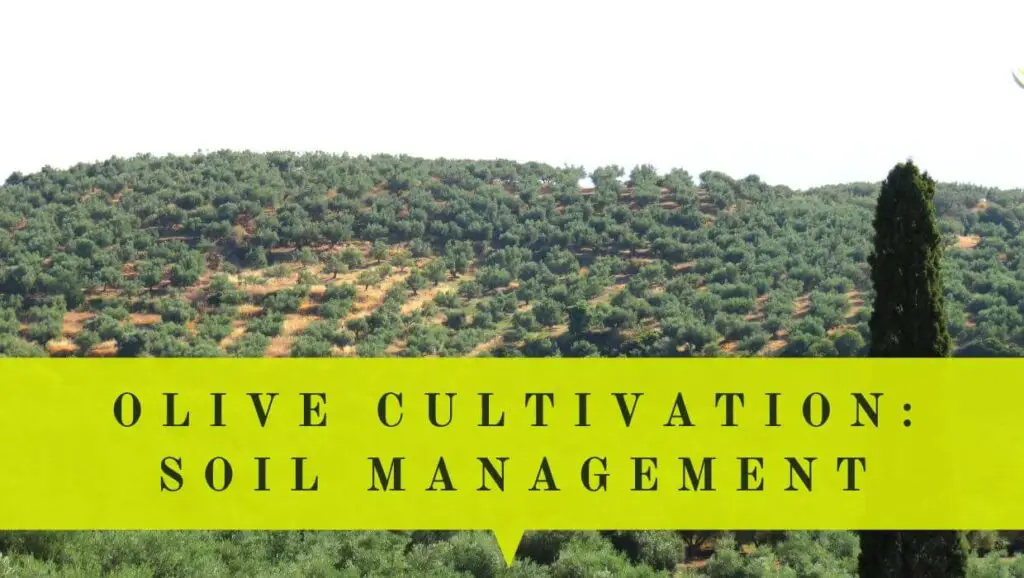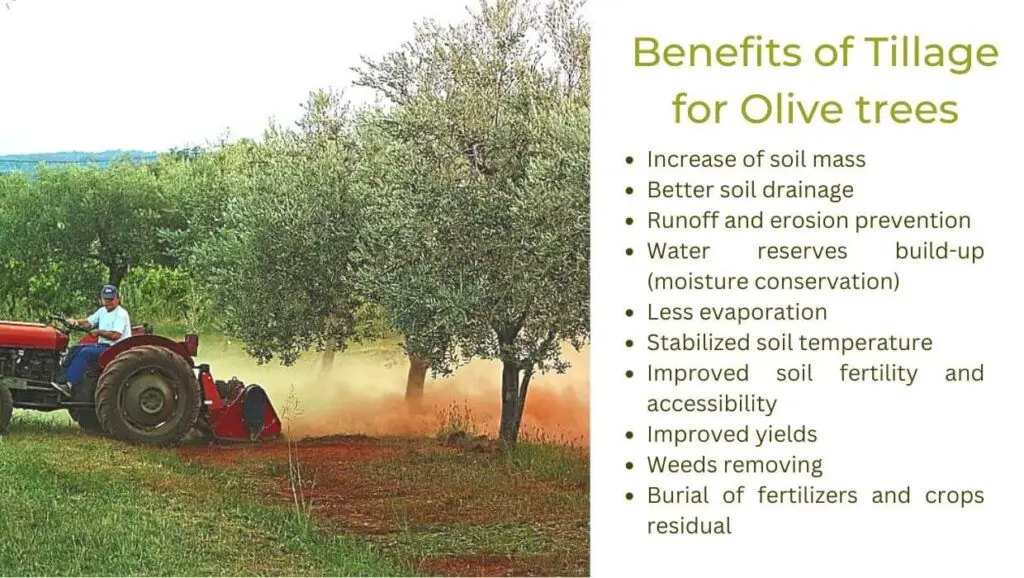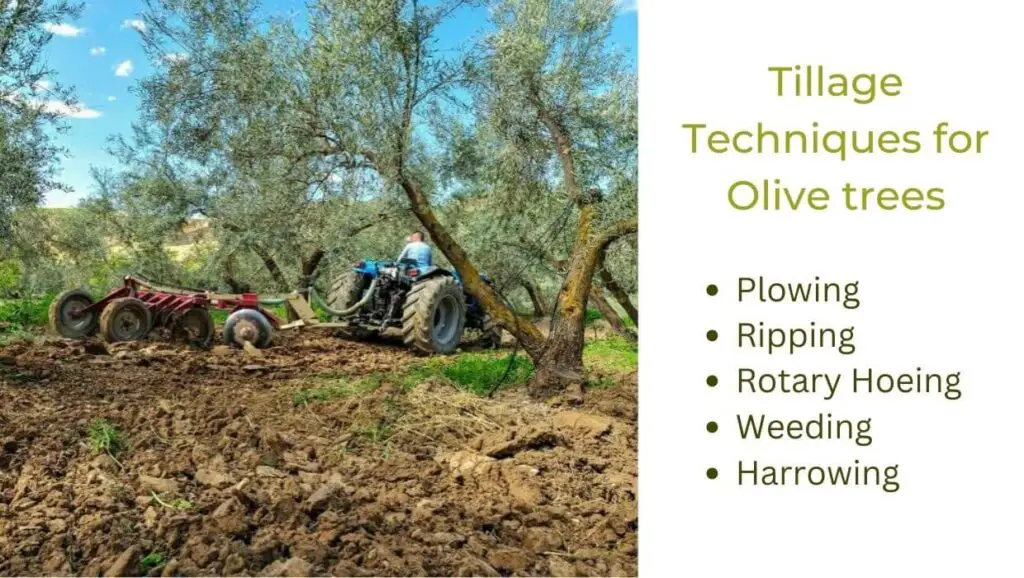This post may contain affiliate links which may generate a small commission from clicks that result in a purchase.
The purpose of olive trees’ soil management is to control weeds and grass surfaces, improve the well-being and biological properties of the soil, and increase the productivity and quality of the olive itself.
For olive trees to thrive, their soil has to maintain two key functions:
- Habitability (“that is fit to live in”)
- Nutrition
Habitability mainly depends on the physical and chemical characteristics of the soil. Nutrition depends on the factors that make nutrients available to the olive trees, which determine the productivity (i.e. fertility) of the soil.
To improve habitability and nutrition, olive tree growers must ensure sufficient microorganisms in the soil. That can be achieved by applying fertilizers and tillage, which are great tools for soil management for olive trees.
Let’s learn more about the soil processes microorganisms are responsible for, the benefits of tillage and various techniques, and the secrets of the soil grassing method.

2.1. Soil Processes
Soil is full of microorganisms responsible for the following processes:
- Mineralization (decomposing soil’s organic matter for energy supply)
- Humification (formation of soil organic matter, vital for improving soil fertility)
- Nitrification (an important step in the global nitrogen cycle needed for olive tree productivity)
- Symbioses (how organisms live together for their mutual, and therefore, intrinsic benefit)
- Parasitism (relationship between two organisms in which one benefits at the expense of the other)
Olive trees’ soil management creates the ability to harness the benefits of microorganisms such as arbuscular mycorrhizal fungi. This fungus forms arbuscular mycorrhiza in olive trees (source). This is the most common mycorrhizal type involved in standard olive tree cropping systems and one of the key components in environmentally friendly agro-biotechnologies (source).
Mycorrhiza microorganisms act as soil biofertilizers, bioregulators, and biocontrol agents (source). They help olive trees to absorb more water and nutrients, particularly those less moving in the soil such as phosphorus. In addition, mycorrhizal fungi process other nutrients such as nitrogen, zinc, calcium, and sulfur.
Furthermore, mycorrhizal fungi biological interaction (i.e., symbiosis) can influence some physiological processes, growth, and development of the olive tree (acts as a bio-regulator). Also, these soil microorganisms can modify the form and structure (i.e., morphology) of the roots, the roots/foliage ratio, and even branching foliage and flowering.
Olive tree growers can manage the microorganisms in the soil by applying fertilizers (nutrients management), pesticides, or tillage.

2.2. Tillage
Tillage is performed mechanically to modify the soil structure of the olive grove.
Tillage Benefits
Tillage benefits are the following:
- Increase of soil mass (active layer)
- Better soil drainage
- Runoff and erosion prevention
- Water reserves build-up (moisture conservation)
- Less evaporation
- Stabilized soil temperature
- Improved soil fertility and accessibility
- Improved yields
- Weeds removing
- Burial of fertilizers and olive crops residual
Usually, for olive groves, extensive tillage is carried out in autumn to increase the water reserve and to bury the phospho-potassic fertilizers. While during the spring or summer period, some harrowing is performed to reduce evaporation and eliminate weeds.
Tillage Techniques

Plowing
Plowing is the most known and commonly used soil tillage technique in agriculture, also widely applied for olive groves. This process allows to removal the horizontal clods from the soil. The clods then will be turned over and shattered, helping the passage of organic substances and providing space and nutrients to the olive trees.
| Cons | Pros |
|---|---|
| Soil structure restored | It affects the equilibrium of the microflora |
| Proper space to expand the roots | Creation of a hard pan layer |
| Increases soil porosity essential for the passage of water, oxygen, and organic matter | Higher energy and economical consumption |
| Strict control of weeds | |
| Reduce the activity of animal parasites |
Plowing is executed with three types of tools:
- Plowshare plow
- Disk plow, that work by traction
- Rollover plow, which works by using the tractor power.
First two tools (the plowshare and the disk plow) work by traction. Thereas, the rollover plow works by using tractor power take-off.
The plow operates by cutting and turning over a slice of soil. The type of plow, the operating speed, and the operation goal can vary.
For example, the complete overthrow of slices is necessary for fertilizing and weed control; while vertical slices improve aeration and rainwater penetration. Using a cylindrical bending breast olive grower can achieve a greater crumbling action, while a helical breast is better for working thin soil. The speed of plowing acts on both the slice overthrow and crumbling: a fast plowing improves the inversion of layers and the pulverization of clods.
The plowshare plow can result in the compaction of the deep soil, called tillage pan. The tillage pan hinders the vertical movement of rainwater and gas exchanges in the soil and the growth of the roots.
The drawbacks of the plowshare plow are:
- excessive clod level that requires other refining tillage
- formation of tillage pan
- high traction power
These disadvantages can be mitigated using the disk plow, which better prepares the soil for seeding and works better for light plowing in loose or medium textured soil.
There are other tillage techniques for the olive grove that can be used as complementary or alternatives to plowing. Among these, the most common are:
Ripping Technique
The ripping technique is unique due to its vertical soil breakup without the layers’ transposition. Ripping tillage uses various anchors (from 1 to 5) that execute a different action on the soil depending on their shape and inter-axle.
Some ripping machinery uses vibrating tools that boost the shattering of the soil and can be joined to rolls or harrows to finish up the surface in a single pass.
Rotary Hoeing
The Rotary Hoeing technique is performed to shatter and remix the soil of the olive grove. It is done by machinery moved with a tractor power take-off with tools that work on a horizontal axle (i.e., millers) or vertical axle (i.e., rototiller).
Rotary Hoeing has the following drawbacks:
- The excessive shattering of soil, which impacts its structure badly
- Formation of superficial crust and hard pan layer
- Fast tool usury
- High working power
- Unsuitable in heavy and/or skeleton soils
Weeding
Weeding is a tillage technique compatible with plowing whose goal is to reduce the clod of the soil and bring up the weed’s roots.
Weeding machinery is designed with bent rigid or elastic rippers and different feet types.
Harrowing
Harrowing executes the following functions:
- Clods refining
- Weeds elimination
- Fertilizers burying
- Superficial crust breaking
Harrowing is performed with various tools of different shapes and dimensions depending on the soil type, soil conditions, and the needs of soil refining for olive trees.
All tillage up to 15 cm (6 inches) of depth is included in the minimum tillage group, with the goal of energy saving, protecting soil structure, and timeliness of work. Also, multifunctional machinery can perform tillage, fertilization, seeding, and chemical weeding of the soil in a single use.
| Soil Type | Tillage Technique |
|---|---|
| Clayey Soil | The minimum tillage can positively prevent erosion due to the remaining crop on the soil surface. |
| Silty Soil | All the tillage techniques are good that do not change the soil structure and the presence of residual crops to avoid damage caused by the beating action of the rain. |
| Sandy Soil | Any tillage technique that excludes deep intervention, while all the minimum tillage techniques generally guarantee the best results |
2.3. Soil Grassing
Soil grassing is a less expensive cultivation technique with a lower environmental impact than traditional tillage. The controlled soil grassing ensures the great activity of the soil biota due to the greater presence of organic matter and the low trouble of soil.
It is possible to implement soil grassing, which can be either natural or artificial, and to partially or wholly cover the surface of the olive grove.
Soil Grassing Benefits
These are the benefits of controlled grassing in the olive groves:
- Soil structure enhancement
- More organic matter in the soil
- Better water absorption
- Prevention of runoff and erosion
- Reduction of compactness
- Improvement of microbial activity and nutritional balance
- Simplified management at lower operating costs
The grassing technique improves soil quality and drainage system according to long-term investigations in the different non-irrigated olive grove soils. It effectively controls soil erosion and olive tree productivity (source).
Soil Grassing Types
Permanent
Permanent is the simplest type of soil grassing, where spontaneous vegetation covers the soil that is mowed or shredded.
Temporary
Opposite to permanent soil grassing, temporary grassing can be used by removing grass with superficial tillage or using herbicides in the dry summer season when the competition for water begins. The grass naturally re-establishes itself during the rainy season and retains its benefits until spring.
Artificial
For artificial grassing the choice of the grass/plant type is very important; these must-have fast growth following planting and to be resistant to pounding and mulching.
However, artificial grassing has some economic and managerial limits, such as the difficulty of choosing the great grass/plants relevant to the soil type and the seeding costs.
Soil Grassing Machinery
Soil grassing machinery is the rotary mower and the shredder. Compared to other tools operating in the soil, they have the following advantages:
- Great working capacity
- Low power needs
Both these machines can be upgraded with an intercept rotary mower, which allows cutting of the grass along the row, avoiding damage to the olive tree trunks. Therefore, the shredder not only grinds the mown grass, it can also be used for pruning residues of olive trees.
Final Thoughts
Olive tree growers must choose the best soil management system for their specific soils and olive crop characteristics.
The most common soil cultivation technique, tillage, can be replaced with other methods to achieve the best soil fertility, prevent soil erosion in slopes, reduce costs, and gain higher incomes.
Read Next
Cultivating Olive Trees: Soil – Part 1
Cultivating Olive Trees: Nutrition – Part 3
Cultivating Olive Trees: Irrigation – Part 4
Hi, I’m Vangelis Kleftogiannis, the founder of Oliviada and an established olive oil expert from Kalamata, Greece. My expertise isn’t just in producing quality Extra Virgin Olive Oil, but also in the cultivation and care of olive trees themselves. I am deeply committed to sharing my knowledge and know-how, helping others understand the intricacies of olive tree growing and the creation of quality olive oil.
Are You Looking to Buy an Olive Tree?
If you are looking to add more potted trees or other plants to your orchard, or if you like to replace a neglected olive tree, the best places to get them are your local nursery or an online nursery.
One of the most reliable and the world's largest online nurseries is Fast Growing Trees. They deliver fast, neat, and healthy plants backed with a 30-day guarantee.
